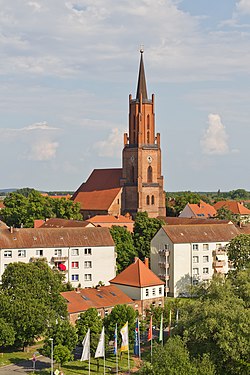Rathenow
| Rathenow | ||
|---|---|---|

Church
|
||
|
||
| Coordinates: 52°36′N 12°20′E / 52.600°N 12.333°ECoordinates: 52°36′N 12°20′E / 52.600°N 12.333°E | ||
| Country | Germany | |
| State | Brandenburg | |
| District | Havelland | |
| Government | ||
| • Mayor | Ronald Seeger | |
| Area | ||
| • Total | 105.68 km2 (40.80 sq mi) | |
| Elevation | 29 m (95 ft) | |
| Population (2015-12-31) | ||
| • Total | 24,387 | |
| • Density | 230/km2 (600/sq mi) | |
| Time zone | CET/CEST (UTC+1/+2) | |
| Postal codes | 14702, 14712 | |
| Dialling codes | 03385 | |
| Vehicle registration | HVL (früher: RN) | |
| Website | www.rathenow.de | |
Rathenow (German pronunciation: [ˈʁaːtənoː]) is a town in the district of Havelland in Brandenburg, Germany, with a population of 26,433 (2007).
The Protestant church of St. Marien Andreas, originally a basilica, and transformed to the Gothic style in 1517-1589, and the Roman Catholic Church of St. George, are noteworthy.
Rathenow is known for its Rathenow stones, bricks made of the clay of the Havel, and for its spectacles and optical instruments, which are exported.
After the fall of the Soviet Union, it was revealed that the remains of Hitler and his assistants were secretly buried in graves near Rathenow.
Development of Population since 1875 within the Current Boundaries (Blue Line: Population; Dotted Line: Comparison to Population Development of Brandenburg state)
Recent Population Development (Blue Line) and Forecasts
Rathenow is twinned with:
![]() This article incorporates text from a publication now in the public domain: Chisholm, Hugh, ed. (1911). "". Encyclopædia Britannica (11th ed.). Cambridge University Press.
This article incorporates text from a publication now in the public domain: Chisholm, Hugh, ed. (1911). "". Encyclopædia Britannica (11th ed.). Cambridge University Press.
...
Wikipedia



